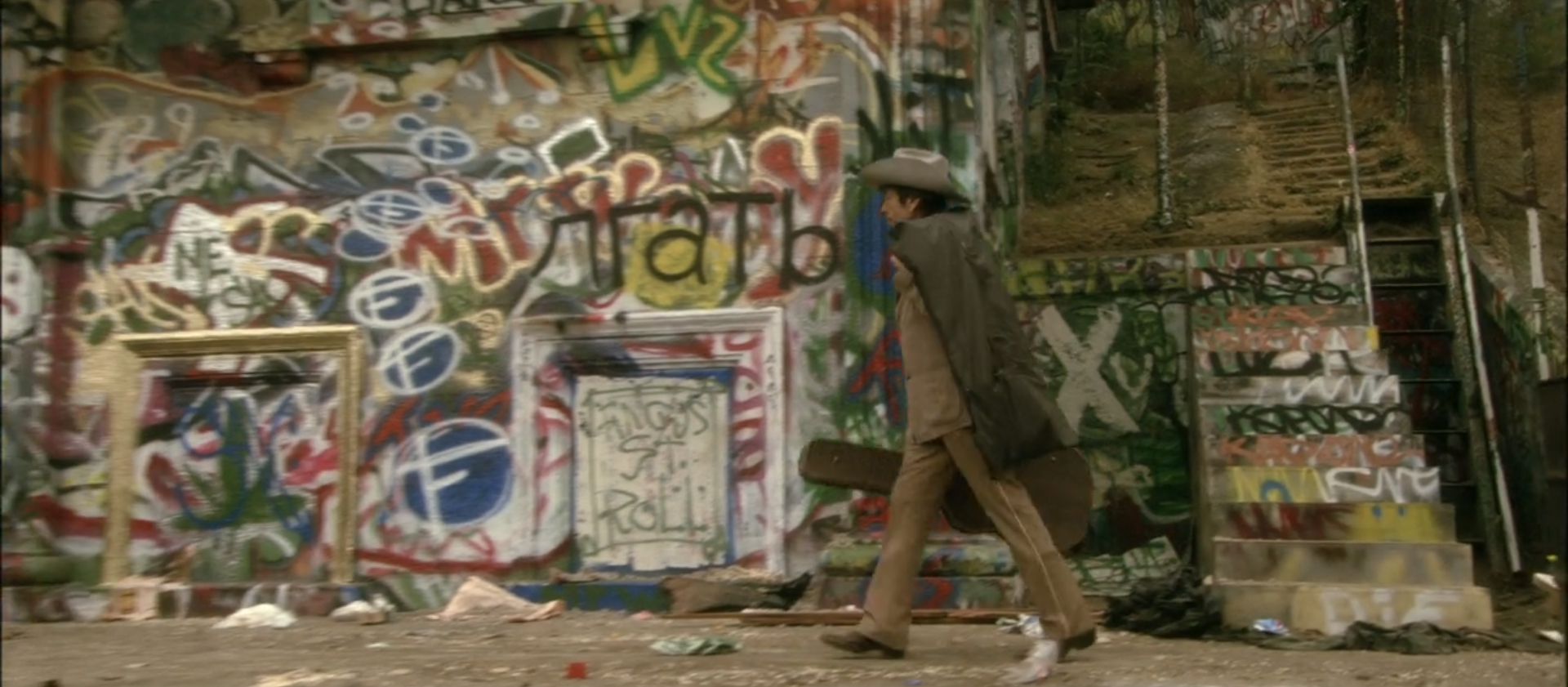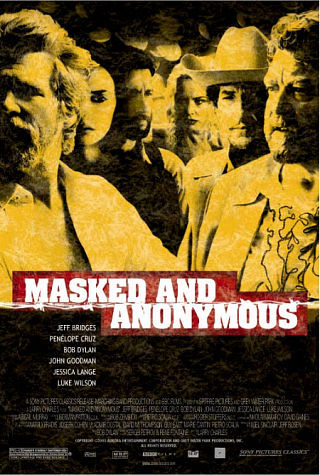

“I stopped trying to figure everything out a long time ago.”
Jeff Bridges, Penélope Cruz, John Goodman, Jessica Lange, Luke Wilson, Angela Bassett, Bruce Dern, Ed Harris, Val Kilmer, Chris Penn, Giovanni Ribisi, Mickey Rourke, Christian Slater, Susan Tyrrell, Fred Ward, Robert Wisdom, Tracy Walters—that, my friends, is an all-star lineup. And yet top billing on Masked and Anonymous goes to its enigmatic co-writer, Bob Dylan, who is on screen far more than any of his costars and a lesser actor than virtually all of them. It’s a testament to his enduring charisma that so many prominent and mid-list actors were willing to make such an odd vanity project with him.
Collaborating with filmmaker Larry Charles, who wrote for Seinfeld and would go on to direct Sacha Baron Cohen in Borat, Brüno, and The Dictator, Dylan uses the cinematic medium just as he’s come to predominantly operate in his main one; that is, cubistically, in an attempt to abstractly explore multiple facets of his fragmentary personality. Critics and fans used to debate the contradictions in Dylan’s work—folk/electric, political/religious, Christian/pagan, garish/sparse, showman/recluse, authentic/performative—but it’s become clear over the years that one of his primary driving forces is the idea of the multiple self; the same idea that Todd Haynes would illustrate in the kaleidoscopic Dylan biopic I’m Not There.
In Masked and Anonymous, Dylan plays Jack Fate, an iconic troubadour bailed out of prison to play a benefit concert for the ailing President of a brokedown future America—or at least we assume it’s America and we assume it’s the future and we assume that’s what the concert’s for, lacking any other textual clues about this decaying geopolitical landscape. We are led to believe, I think, that Fate is the son of the President and was jailed because they both loved the same woman. The character is equivalent to the layman’s perception of Dylan, gruff, mysterious, poetic, semi-fictionalized, speaking in non sequitur adages. But surrounding Dylan are… more Dylans? Personifications of half-baked song ideas? Concert promoters, journalists, blackface minstrels, newspaper editors, politicians, groupies, bartenders, celebrity impersonators, all of them representing some or another niche aspect of Dylan’s creative identity, even as the soundtrack and numerous diegetic performers take a shot at covering his songs, sometimes in different languages. The film flits amongst this disoriented and displaced motley crew, but even within any particular scene, where it ostensibly focuses on a single interaction, one single dimension of Dylan’s persona, one single lyric-cum-dialogue, it seems driven by the man’s mercurial impulses.
To wit, what are we to make of Val Kilmer’s “animal wrangler,” who’s found on the outskirts of the venue, speaking in obscure verse, handling snakes, and cleaving the head off of a rabbit? “If I see a crack in the sidewalk, it’s more beautiful to me than any human being. A crack in the mud at the bottom of a sun dried lake, I count them more beautiful than any human being. You know what I mean?” That’s Dylan speaking, obviously, but then we cut to a different clip, where the animal wrangler, or Kilmer himself (or Dylan?), is nuzzling the unharmed critter. This is a behind-the-scenes snippet spliced right into the main film, toying with the line between fact and fiction as he did with Renaldo & Clara and Rolling Thunder Revue. There’s also Ed Harris as the ghost of a murdered blackface performer and Luke Wilson clubbing Jeff Bridges to death with Blind Lemon Jefferson’s guitar. (For whatever it’s worth, the combination of Luke Wilson, a crumbling future America, and a mocking tone bring to mind Mike Judge’s Idiocracy.)
What does it all mean except that it seemed fitting to Dylan at the time, in the same way that ditching a rehearsal with the Grateful Dead or ending his first marriage felt like decisions properly made on mere hunches and whims? This is a man unafraid of sabotaging and undercutting things he’s previously poured his lifeblood into, if whichever Dylan is behind the wheel at the time deems it appropriate. After all, many of his most famous recordings were captured somewhat spontaneously, rewritten on the fly and laid down on tape before the backing band even figured out the new tempo and chord changes. Like he tells Bridges’ goading reporter, who asks him if he’ll ever “let it all hang out” like Hendrix or Zappa, “It always has been hanging out.”
Of course, sometimes following his muse has led him astray—if we want to phrase it that way (he’s been unpalatable but hardly uninteresting)—and the disjointed, allusive stanzas of, say, Love and Theft or Modern Times, work much better than the satirical, self-referential, avant garde, dystopian fantasia of Masked and Anonymous, where we must constantly gaze upon the inscrutable mask behind which such a compelling creative mind is at work. The rhythm of the music and repeat listens can usually give context and meaning to the odd couplets that Dylan conjures from his deep well of cultural memory, but here he backs his musings not with timeworn storytelling structures but with strange plotting, awkward editing rhythms, and absurd juxtapositions. Unless we count the musical performances themselves, there’s no connective tissue between Dylan’s vague ruminations and so the hints of profundity that mark his best work never materialize.
Masked and Anonymous is cobbled together from Dylan’s back pages, and it’s far from a cinematic masterpiece; nevertheless, it’s a fascinating glimpse into the artistic life of the greatest songwriter of the last century, and remains true to the notion that great art should create a self-sufficient universe that doesn’t need interpretation, even if it is not great art itself and will receive the interpretation anyway. It’s certainly the work of a man who is still busy being born.
Sources:
Martin, Adrian. “Another Kind of River (A Note on Bob Dylan and the Cinema)”. Film Critic: Adrian Martin. 2006.
Wright, Brett. “Injuring Eternity: ‘Masked And Anonymous’ (2003), Or Bob Dylan’s Masquerade”. Split Tooth Media. 14 March 2022.